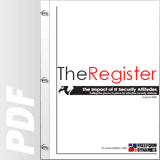No hiding place? UK number plate cameras go national
But there are speed bumps on the road to the surveillance society
Posted in Music and Media, 24th March 2005 18:20 GMT
Free whitepaper – Virtualization and Cloud Computing
The national rollout of the UK police's ANPR (Automatic Number Plate Recognition) system is kicking off, with the goal of deploying a network of over 2,000 cameras on motorways, major roads and city centres. The system is claimed to be able to run database checks on 3,600 plates per hour, on vehicles travelling at speeds of up to 100 mph - but there are just a few snags.
The UK ANPR system is intended to automatically alert police if a car is stolen, if road tax hasn't been paid or the MoT is out of date, or if the driver is uninsured. For good measure, it's supposed to check whether there is a warrant for the arrest of the driver, or whether the driver is for some reason under police surveillance. Register readers being quick, most of you will have spotted a few slight snags there, but we'll get back to them; the most immediate problem is the state of the databases being checked.
The DVLI is currently improving its road tax database and computerising MoT tests, but although some people can now renew their road tax online (the site is down for engineering this weekend, so we won't give you the link), their ability to do so is currently substantially limited by the rareness of MoT centres handing out the new style computerised certificates. UK readers may have seen terrifying 'no hiding place for dodgers' ads on the TV recently, but the fact is that the MoT system rollout is proceeding very slowly, and the police's ability to use ANPR to detect MoT and road tax offences will be largely limited to use of the old style watch list for a while yet. The Home Office was enthusiastic about the success of a pilot of mobile ANPR systems (another class of camera we'll be seeing more of) last year, but one of the things it wasn't quite so noisy about was the report's pointing out that the DVLI alert list had high error rates, up to 40 per cent.
Ministers have subsequently insisted that the accuracy of the database has been improved substantially. Failing to pay also now incurs an automatic penalty a month after the deadline, which should have some impact on inaccuracies caused by late payment. It won't however eliminate them until the police have real time access to a DVLI database that updates as soon as tax is paid.
Catching uninsured drivers is rather more complicated. Again it's dependent on developing police access to an up to date database, in this case one owned by the insurance companies. But the person behind the wheel is not necessarily the registered keeper of the vehicle, and may or may not be legally insured to drive it, so ANPR doesn't of itself add massively to police capabilities here. The difficulty here is that the system can produce data associated with the vehicle, but does not check any kind of number plate attached to the driver (yet...?).
Similar difficulties clearly arise if police are pursuing arrest warrants, outstanding fines or monitoring suspects. It's likely that a reasonable percentage of those stopped will be the people being sought (obviously this doesn't apply to surveillance targets, because you just watch them), but quite a number of them won't be. Errors in the database could also be dangerous, if, for example, it's thought the vehicle might be driven by a dangerous armed criminal, and it will still be possible for the individual apprehended to give a false name and address and fail to report to a police station afterwards.
The cloning of number plates, already encouraged in London by the Congestion Charge, is also likely to increase as a consequence of ANPR, making life difficult, possibly hazardous, for the owners of the vehicles cloned. Other errors and omissions will arise from the fact that the all-singing, all-dancing, all-watching police database is not yet with us, and will not be with us for some time yet.
A PITO document on ANPR plans contains a couple of interesting nuggets. This asks whether ANPR could be "part-funded by using fines money generated by intercept teams", and speaks of "Project Lantern [which] is being developed to deliver roadside fingerprint devices to ANPR teams to assist with the identification process." Overtly funding ANPR from fines might be politically difficult in the short term, as a system being billed as a 'vital crime-fighting tool' could easily be seen as 'Son of Gatso', simply an extension of a speed camera system that is widely perceived as a tax on motorists. And as the ANPR system will tend to bite most heavily on minor offenders (because they're most likely to be on the database, to have a correct address listed, and to pay up when the fine comes in the post) there's an argument to support this.
Widespread deployment in city centres and piggy-backing on existing CCTV sites will however generate fairly large lists of minor offenders, and unless you're just not going to bother fining them there's potentially quite a lot of revenue there. The first couple of years figures, including the rates of failure to identify and of failure to pay, should be interesting.
And what about the "roadside fingerprint devices"? Last year it was revealed that ID cards wouldn't stop people getting away with motoring offences by giving police a false name and address and failing to report to a police station to identify themselves. The Government has told us repeatedly that police will not have the power to demand an ID card, which theoretically means that the standard false name gambit will still work. However, if mobile fingerprint devices are being delivered to ANPR teams to "assist with the identification process" then we clearly do have scenarios where police can demand ID developing.
In the case of an ANPR stop the police obviously have reason to believe the person behind the wheel might be guilty of an offence, so once the ID scheme's national identity register exists, and they have access to the fingerprints of everybody on it, a roadside fingerprint will be a mechanism for that person to establish their identity in order to show they are not the individual being sought. Alternatively, a refusal to submit to a fingerprint check could be argued to give the police reasonable suspicion that the individual has given a false identity. In principle therefore it seems feasible for fingerprinting of ANPR stops to become custom and practice.
Checks of this sort would also provide another potential source of offenders. As immediately envisaged, the police ANPR system detects outstanding vehicle-related and keeper-related offences. Widespread fingerprinting of ANPR stops would however add to this outstanding offences related to the individual. Obviously you'd have to be a bit unlucky to be wanted by the police while driving a car owned by somebody else who was wanted by police, but you'd be the associate of a known criminal, right? So maybe not that unlucky... ®
Free whitepaper – Virtualization and Cloud Computing
- Rate this article

 Linux on the Desktop
Linux on the Desktop The Register 2007 Tech Barometer
The Register 2007 Tech Barometer The Impact of IT Security Attitudes
The Impact of IT Security Attitudes The Register's Green Computing Debate
The Register's Green Computing Debate
